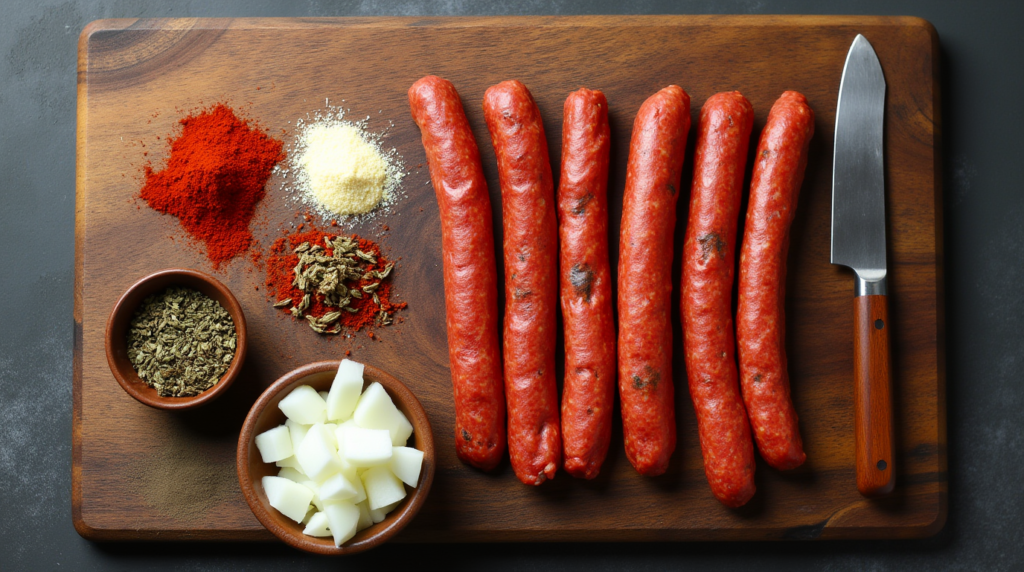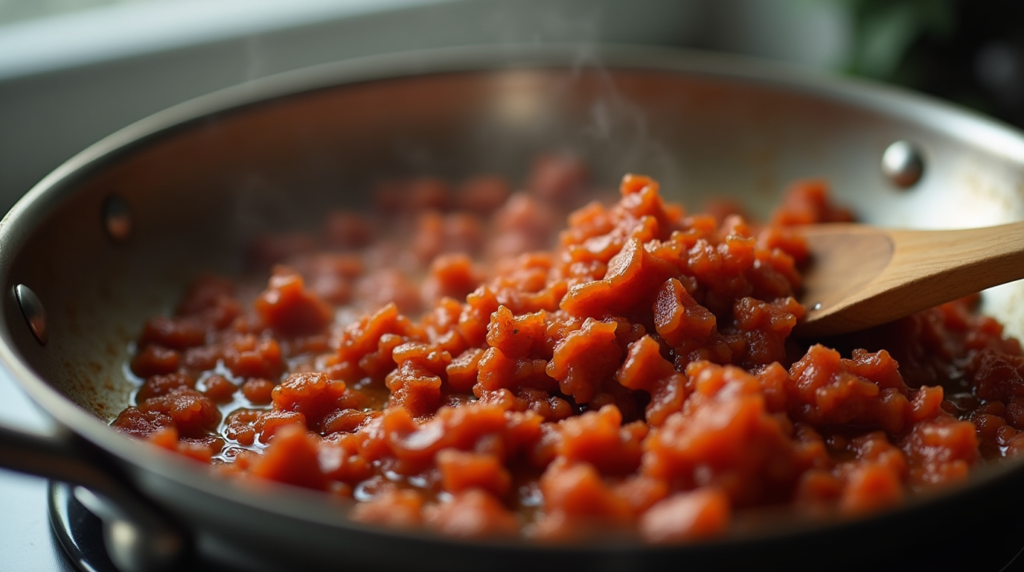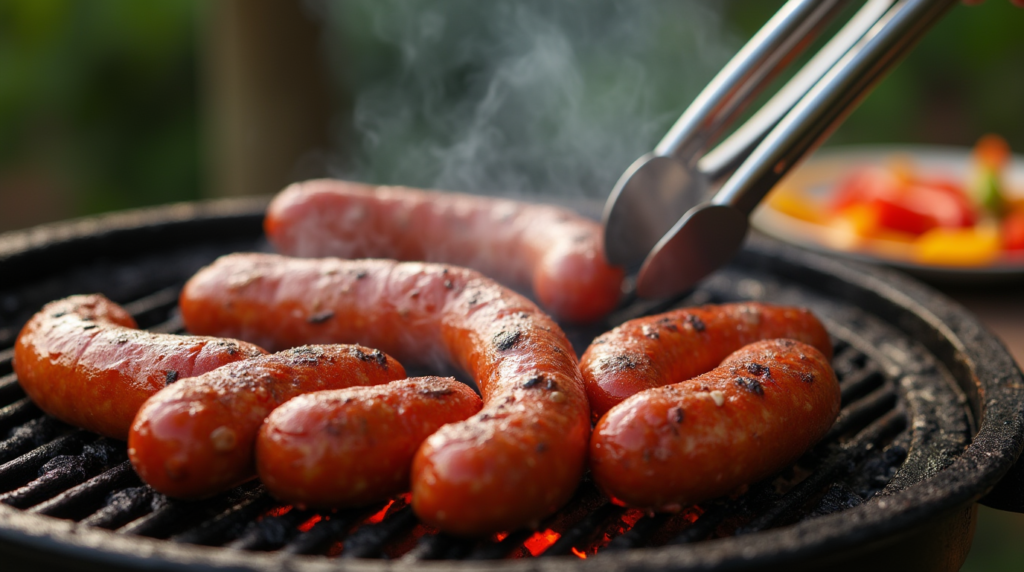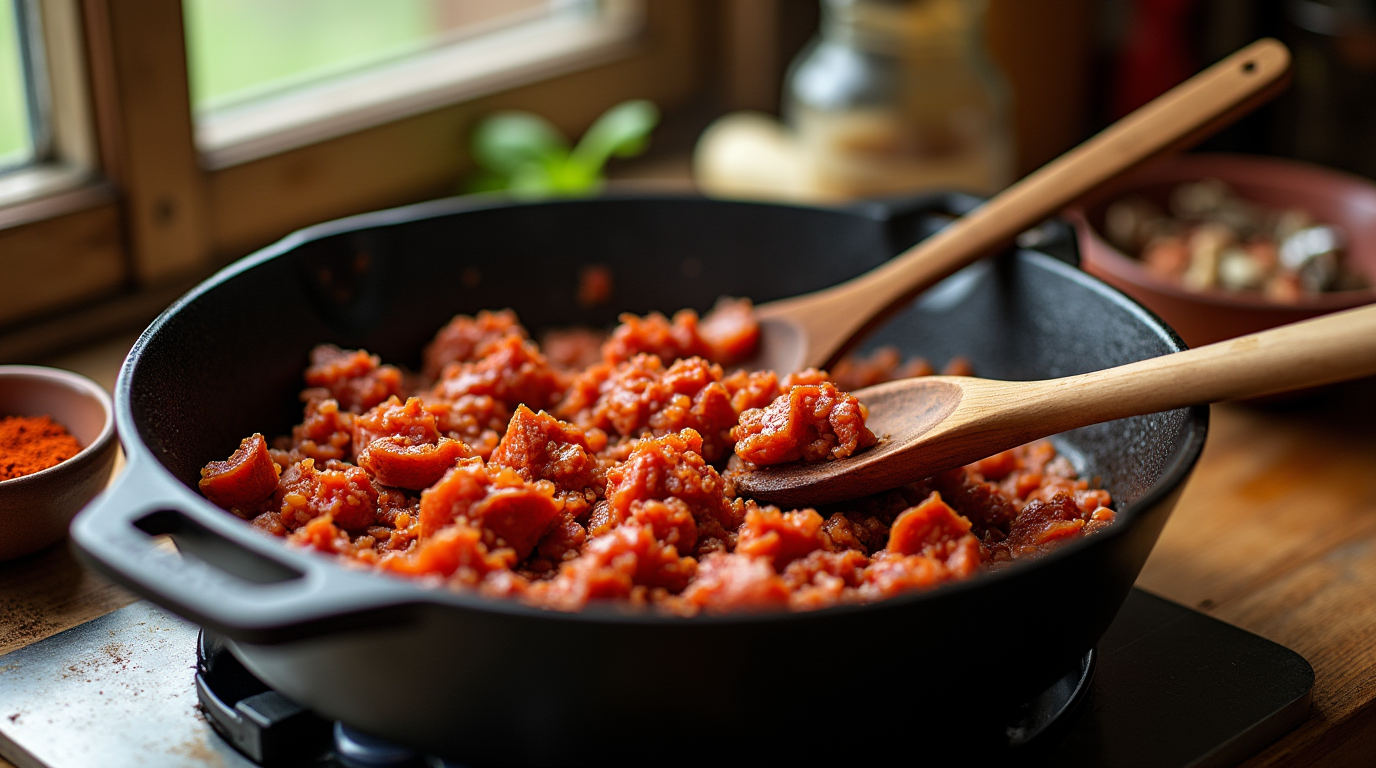Understanding Chorizo
Chorizo is a versatile and flavorful ingredient cherished in many cuisines. Perfectly cooked chorizo can elevate a variety of dishes, whether it’s a hearty breakfast or an indulgent dinner. To explore innovative ways of preparing this ingredient, visit Air Fryer Chorizo Recipes. Understanding its origins, types, and unique qualities can further enhance your culinary creations.
What Is Chorizo?
Chorizo is a type of sausage made from ground meat, typically pork, seasoned with a blend of spices. Its rich, smoky flavor comes from ingredients like paprika and garlic. Chorizo is enjoyed worldwide, but its preparation and use vary by region. How to prepare chorizo depends on whether it’s raw or cured, as each requires specific cooking methods for optimal flavor.
Types of Chorizo: Spanish vs. Mexican
Chorizo comes in two main varieties: Spanish and Mexican. Spanish chorizo is cured and ready to eat, often sliced and served with bread or cheese. It’s seasoned with smoked paprika, giving it a distinctive red hue. On the other hand, Mexican chorizo is fresh and requires cooking before eating. This variety is spicier and often used in tacos, burritos, or scrambled eggs. Cooking techniques for chorizo, such as frying or grilling, vary depending on the type, but both forms offer unique flavors that enhance countless recipes.
Key Ingredients in Chorizo
The key ingredients in chorizo are what give it its signature taste and texture. Paprika is essential for its smoky flavor, while garlic and oregano add depth. In Mexican chorizo, chili peppers bring heat, making it a favorite for spicy dishes. Meanwhile, Spanish chorizo relies on smoked paprika for a milder, smoky profile. Understanding these ingredients can help you explore the best chorizo cooking methods and experiment with recipes.

Nutritional Profile of Chorizo
Chorizo is a flavorful addition to many meals, but it’s also important to consider its nutritional profile. It is high in protein and fat, making it a satisfying ingredient. However, its sodium content can be significant, so moderation is key. Tips for cooking chorizo include pairing it with nutrient-rich ingredients like vegetables or legumes to create a balanced meal. When you know how to prepare chorizo, you can enjoy its rich flavor while maintaining a healthy diet.
Preparing Chorizo for Cooking
Preparation is key to achieving perfectly cooked chorizo that enhances your dishes. From selecting the right type to proper storage and pre-cooking steps, understanding these basics will ensure flavorful results every time.
Choosing the Right Chorizo for Your Dish
Selecting the ideal chorizo depends on the dish you’re preparing. Spanish chorizo works well in charcuterie boards, soups, and stews due to its cured, smoky flavor. On the other hand, Mexican chorizo is perfect for tacos, burritos, and breakfast scrambles because of its fresh, spicy nature. Knowing how to prepare chorizo starts with identifying the type that best complements your recipe. Additionally, consider whether you prefer mild or spicy flavors to align with your dish’s overall taste profile.
How to Properly Store Chorizo
Proper storage is essential to maintain the quality and safety of chorizo. Store fresh Mexican chorizo in the refrigerator and use it within a few days for optimal freshness. For longer storage, freezing is an excellent option. Cured Spanish chorizo can be kept at room temperature if unopened, but once sliced, refrigerate it to preserve its flavor. Tips for cooking chorizo include ensuring it’s properly stored to prevent spoilage and retain its signature taste.
Pre-Cooking Preparations
Prepping chorizo correctly is crucial for achieving the best results. For Mexican chorizo, remove the casing before cooking, as it allows the sausage to crumble easily. This step is particularly important for recipes requiring browned chorizo, such as tacos or pasta. If you’re using Spanish chorizo, slice it into uniform pieces to ensure even cooking or easy incorporation into dishes. Cooking techniques for chorizo often involve frying, grilling, or sautéing, so pre-cutting and portioning will save time and ensure consistency.
Cooking Methods for Chorizo
Chorizo is a versatile ingredient that shines when cooked using the right techniques. Each method brings out unique flavors and textures, ensuring perfectly cooked chorizo for any dish. Whether you’re sautéing, grilling, or baking, these cooking techniques for chorizo will help you master its preparation.
Sautéing Chorizo on the Stovetop
Sautéing is one of the most popular methods for preparing chorizo. It’s quick and effective, making it ideal for recipes like tacos, scrambled eggs, or pasta. To start, heat a pan over medium heat and add the chorizo. If you’re using Mexican chorizo, crumble it as it cooks to achieve an even texture. For Spanish chorizo, sliced pieces should be browned lightly to release their smoky oils. Additionally, this method enhances the chorizo’s flavor while preserving its juiciness.

Grilling Chorizo for Outdoor Feasts
Grilling chorizo is perfect for outdoor gatherings and barbecues. This method adds a charred, smoky flavor that complements the sausage’s spices. Place whole chorizo links on a preheated grill and cook over medium heat, turning occasionally until they’re evenly browned and cooked through. Moreover, grilling gives the chorizo a crispy exterior while keeping the inside tender and flavorful. Serve it with grilled vegetables or crusty bread for a complete meal.
Baking Chorizo for a Crispy Texture
Baking chorizo in the oven is an easy, hands-off method that ensures even cooking. Preheat your oven to 375°F (190°C) and place the chorizo on a baking sheet. Bake for 20–25 minutes, flipping halfway through for consistent browning. This technique works well for both fresh and cured chorizo, especially when preparing dishes like casseroles or breakfast skillets. In addition, baking is a great way to achieve a crispy texture without added oil.

Simmering Chorizo in Stews or Soups
Simmering chorizo adds depth and richness to stews, soups, and chili. Slice or crumble the chorizo, then add it to your pot during the cooking process. Its spices and oils will infuse into the broth, enhancing the dish’s overall flavor. This method works particularly well with cured Spanish chorizo, as its robust flavor complements hearty recipes like lentil stew or paella. Furthermore, simmering ensures the chorizo stays tender while blending seamlessly with other ingredients.
Combining Cooking Techniques for Maximum Flavor
For the best results, you can combine multiple cooking methods to create layers of flavor. For instance, grill chorizo for a smoky char, then slice it and simmer in a sauce or stew. Similarly, sauté chorizo first to release its oils, then bake it in a casserole for added crispiness. This approach allows you to explore the best chorizo cooking methods while tailoring the dish to your preferences.
Pairing Chorizo with Other Ingredients
Chorizo’s bold and smoky flavor makes it an excellent ingredient to pair with a wide variety of foods. Whether you’re preparing a traditional dish or experimenting with fusion cuisine, understanding how to prepare chorizo with complementary ingredients ensures delicious results.
Traditional Spanish Pairings
In Spanish cuisine, chorizo is often paired with simple, robust ingredients that highlight its rich flavor. Traditional pairings include crusty bread, Manchego cheese, and olives, creating a classic tapas platter. Chorizo also works beautifully in stews with lentils, chickpeas, or potatoes, where its oils and spices infuse the dish with depth. Moreover, adding chorizo to paella enhances the smoky undertones and complements the saffron and seafood typically used. These dishes showcase the best chorizo cooking methods for traditional Spanish fare.
Chorizo in Mexican Cuisine
Chorizo is a staple in Mexican cooking, where it pairs seamlessly with bold, spicy ingredients. Tacos and burritos often feature chorizo combined with fresh cilantro, diced onions, and lime for a flavorful bite. It also works well with eggs in breakfast dishes like huevos con chorizo. Additionally, Mexican chorizo’s spices complement creamy elements such as avocado or queso fresco, balancing the heat and enhancing the overall taste. When preparing these dishes, using the right cooking techniques for chorizo ensures optimal flavor and texture.
Fusion Recipes with Chorizo
Chorizo’s versatility allows it to shine in fusion recipes, blending with flavors from various cuisines. For instance, chorizo can be added to pasta dishes with creamy sauces or used as a topping for wood-fired pizza. Furthermore, it pairs well with Asian-inspired ingredients like soy sauce, ginger, and bok choy in stir-fries. For a unique appetizer, combine chorizo with goat cheese or figs to create a sweet and savory flavor profile. These innovative pairings demonstrate how chorizo can transform traditional recipes into something extraordinary.
Tips and Tricks for Cooking Chorizo Perfectly
Mastering the art of cooking chorizo ensures its flavors shine in every dish. By following these tips, you can achieve perfectly cooked chorizo with the ideal texture and taste.
Avoiding Overcooking or Burning
Overcooking chorizo can result in a dry or rubbery texture. To prevent this, cook it over medium heat and monitor it closely. For fresh Mexican chorizo, stir frequently to avoid sticking or burning, and cook until it’s fully browned but still moist. For cured Spanish chorizo, a light sear is enough to bring out its smoky flavor. Additionally, using a non-stick or cast-iron pan helps maintain even heat distribution.
Adjusting the Spice Level
Chorizo’s spice level can vary depending on the type and brand. If you find it too spicy, pair it with neutral ingredients like rice, potatoes, or bread to balance the heat. Moreover, you can reduce the spice by cooking it with a splash of cream or milk. For those who prefer more heat, add chili flakes or hot sauce during cooking to enhance its fiery kick. This flexibility makes chorizo adaptable to different flavor preferences.
Using the Right Pan or Grill
The cookware you use significantly impacts the outcome. A heavy-bottomed skillet, like cast iron, is ideal for sautéing chorizo as it retains heat well and ensures even cooking. For grilling chorizo, preheat the grill to medium heat and lightly oil the grates to prevent sticking. Furthermore, using a grill basket for smaller pieces ensures they cook evenly without falling through the grates.
Timing and Temperature for Optimal Results
Timing and temperature are crucial for achieving perfectly cooked chorizo. Fresh chorizo should be cooked to an internal temperature of 160°F (71°C) to ensure it’s safe to eat. Cured chorizo, on the other hand, only needs to be heated through, so keep the cooking time brief to preserve its texture. Additionally, allow cooked chorizo to rest for a few minutes before serving to let the flavors settle and the juices redistribute.
Popular Recipes Featuring Chorizo
Chorizo’s bold flavors make it a star ingredient in a variety of dishes. Whether you’re preparing breakfast, lunch, or dinner, these popular chorizo recipes showcase its versatility and rich taste.
Classic Chorizo and Potato Hash
Chorizo and potato hash is a hearty and flavorful dish perfect for breakfast or brunch. To prepare, sauté diced potatoes with onions until golden brown, then add crumbled chorizo and cook until fully browned. The spices from the chorizo infuse the potatoes, creating a satisfying combination. Additionally, topping it with a fried egg or fresh herbs adds an extra layer of flavor.
Spicy Chorizo Tacos
Spicy chorizo tacos are a staple in Mexican cuisine and a favorite for taco nights. Cook fresh chorizo in a skillet until browned, then serve it in warm tortillas with toppings like diced onions, cilantro, and lime juice. Moreover, adding avocado or queso fresco balances the heat, making the tacos irresistible. These tacos are easy to make and always a crowd-pleaser.
Chorizo Paella
Chorizo paella is a Spanish classic that combines rice, vegetables, and proteins into one flavorful dish. Sauté sliced chorizo with onions, garlic, and peppers before adding rice and saffron-infused broth. Incorporate seafood or chicken for a complete meal. Furthermore, cooking paella in a wide, shallow pan ensures the rice absorbs the spices and forms a crispy bottom layer, known as socarrat.
Chorizo-Stuffed Peppers
Chorizo-stuffed peppers are a versatile dish that works as an appetizer or a main course. Hollow out bell peppers and fill them with a mixture of cooked chorizo, rice, and cheese. Bake until the peppers are tender and the cheese is melted. In addition, experimenting with different cheese varieties or adding black beans can create unique flavor profiles.
Creamy Chorizo Pasta
Creamy chorizo pasta is a comforting and indulgent dinner option. Sauté crumbled chorizo with garlic and onions, then stir in heavy cream or a tomato-based sauce. Toss the sauce with your favorite pasta, such as penne or fettuccine, and finish with grated Parmesan and fresh basil. Moreover, the smoky flavor of the chorizo pairs perfectly with the richness of the sauce, making it a standout dish.
FAQs About The Best Way To Cook Chorizo
Is Chorizo Gluten-Free?
Most chorizo is gluten-free, but always check the label for additives.
Can Chorizo Be Cooked Without Oil?
Yes, chorizo releases its own fat while cooking, so oil is usually unnecessary.
How Can I Use Leftover Chorizo?
Use leftover chorizo in scrambled eggs, pasta, soups, or tacos for added flavor.
Conclusion
Mastering cooking techniques for chorizo unlocks its bold flavors and versatility, making it a valuable addition to any meal. Whether you’re sautéing, grilling, or simmering, understanding how to prepare chorizo ensures delicious results every time.
Additionally, experimenting with unique pairings, adjusting spice levels, and combining techniques allows you to create exciting dishes that impress your guests. With practice and creativity, chorizo can become a standout ingredient in your culinary repertoire.

